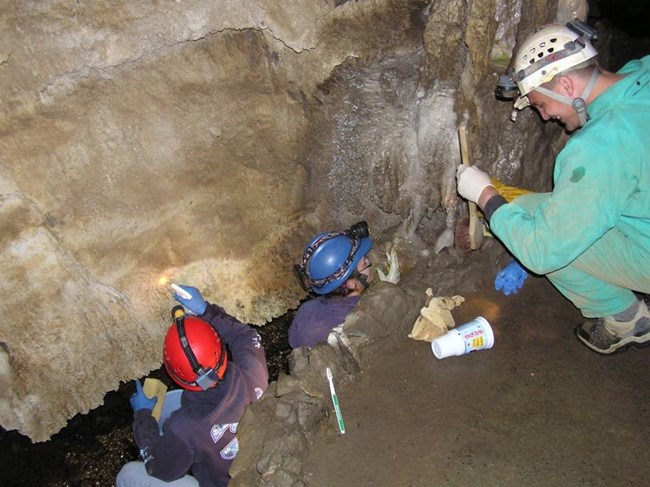|
Efforts to protect and manage caves are nearly as old as the parks themselves. The parks' first superintendent, Walter Fry, gave detailed descriptions of five of the caves in his 1918 annual report. Crystal Cave has been one of the parks' primary visitor attractions since 1941. In the 1970s, the Cave Research Foundation documented more than 80 caves in Sequoia and Kings Canyon. However, it was the discovery of Hurricane Crawl Cave in 1986 that encouraged the parks to begin an active cave management program. This effort resulted in the employment of a "cave specialist" in 1992 and the completion of a Cave Management Plan. This plan defines management actions to protect caves, including what passages are open to visitation, what sections have visit restrictions, and what passages are completely closed to protect delicate cave features. In general, caves in the two parks are managed by category. Some caves can be visited by anyone at any time. Other caves, with rare and sensitive animals or mineralogical features may be closed to entry. A few caves are set aside for research and study. Some others that are delicate or dangerous require the presence of an experienced trip leader known as a "Trustee" before access is allowed. Six park caves are gated, meaning that the entrances contain locked gates of metal bars that protect the cave from uninformed trespassers or which protect any trespassers from dangers in the cave. Most of the caves are small and found in isolated sections of the parks, far from any roads. 
NPS photo RestorationWhile restoration in a national park seems surprising, past visitors and employees in the parks have made reversible mistakes that damaged and altered caves. In some cases, caves can restore themselves through natural processes that remove or cover dirt, graffiti, paint and soot. This process is happening right now in Clough and Crystal caves. Restoration projects have removed tons of blast rubble dumped into Crystal Cave during trail construction in the 1930s. Work in the cave has removed damaging lint and dirt from formerly pristine walls. In 1998 a workroom built into the cave was partially restored in the hope that this would provide more habitat for Pimoa spiders that live only near the cave's four entrances. Cave enthusiasts first explored Soldiers Cave in 1949 and 1950. Through the decades that the cave has been open for recreational caving trips since then, hundreds of square feet of the cave's walls were muddied and damaged. Unfortunately the cave combines muddy areas with passages that have beautiful white walls and delicate formations. Water diverted from a nearby stream for a few days in 1994 and 1995 was used to clean these surfaces and restore the cave to its original appearance and character.
Even the lights that are used to illuminate Crystal Cave for cave tours can cause undesirable impacts to the cave. Near cave lighting fixtures various kinds of lampenflora may grow. These can include mosses, algae, and ferns. Lampenflora are unsightly and may discolor cave formations. Recently, National Park Service staff did research to test different recommended chemical concentrations of sodium hypochlorite to kill these undesirable plants and to learn how the presence and food web dynamics of springtail invertebrates were affected by changes in lampenflora. To learn more, you can link to the abstract for the published paper. Managing a park cave that is open to cave tours involves numerous decisions and management actions to balance protecting cave formations and animals while providing opportunities for visitors to enjoy and learn about caves. 
NPS photo Mapping and ResearchMaps are a key requirement for proper management and research in caves because they document the caves, their features, and their extent. The parks’ cave that has guided tours, Crystal Cave, was mapped between 1995 and 1998. From the fieldwork, a series of maps was produced that document the cave's mineralogical features, its exploration history, passage elevations, streams and lakes, management restrictions, lighting system, and much more. Maps have also been completed for Hurricane Crawl and Soldiers caves. The Cave Research Foundation coordinated a project to produce more than 80 quadrangle maps of Lilburn Cave, showing this very complex cave in detail. Visit the cave maps page to see examples of maps for Soldiers and Crystal caves. Scientists and explorers have made important discoveries in the parks’ caves. Scientists work in Lilburn Cave to understand the complex movements of water and sediments through the cave system. Biologists have documented new species in Clough, Hurricane Crawl, and Kaweah caves. Explorers have extended the length of Lilburn Cave to more than 20 miles, and the exploration of Hurricane Crawl Cave led to the discovery of an entirely new and unique cave system. Research provides important information about cave and karst physical and chemical characteristics and dynamics, and the variety of animal life these unique habitats support. More InformationSee the Cave/Karst Systems page for additional information about cave formations and animals. For more information about the parks' caves, contact the Physical Sciences Program at 559-565-3777. Visit the page on Crystal Cave if you are interested in going on a cave tour. Information about caves throughout the national park system is also available online, including details about protection and management, public policy, and photos. |
Last updated: September 25, 2017
